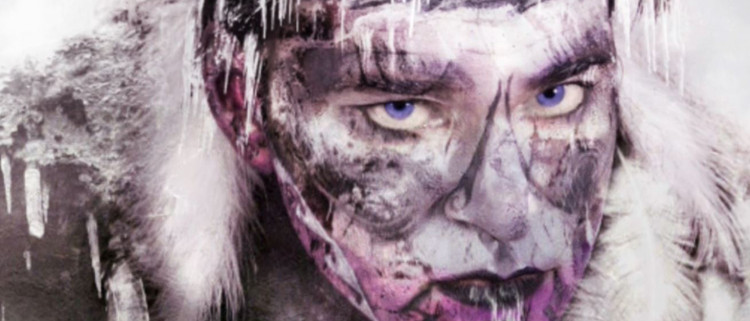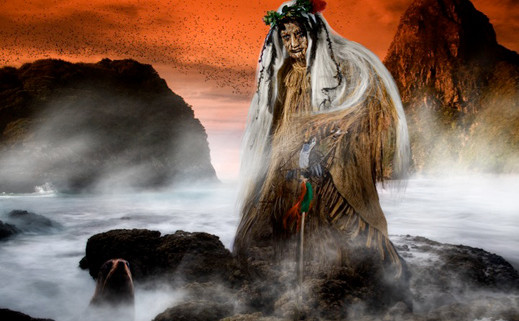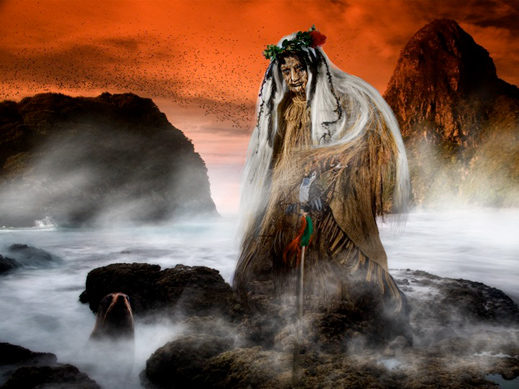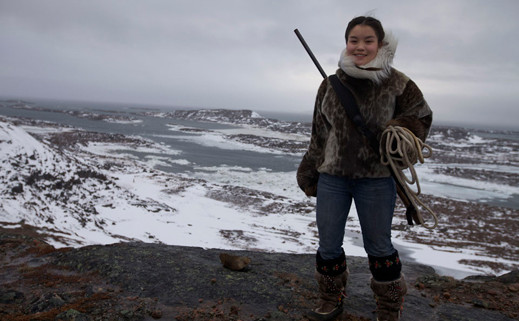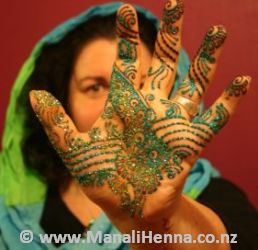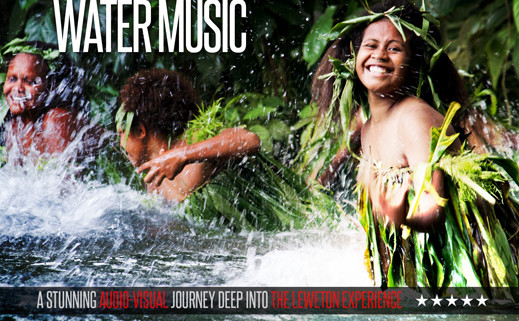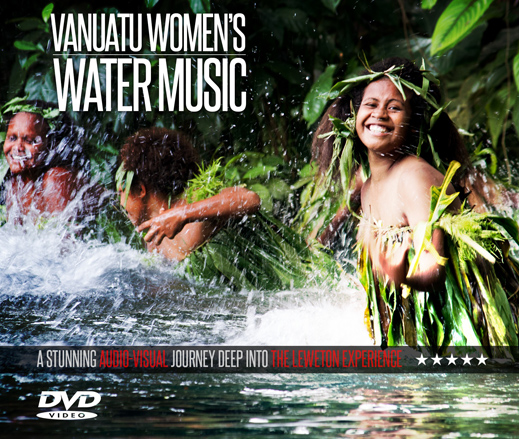Night Projections at SCANZ 2015
/in 2015 Projects, 2015 Schedules /by Ian ClothierFour artists will present video projects at night in Pukekura Park, starting 9pm on Friday 30th January on the Boat Shed Lawn. The evening runs until 11pm. The evening commences the SCANZ 2015 International Celebration of Water and Peace, with events starting at the Huatoki Plaza on Saturday 31st of January and Sunday 1st February starting at 11am and running till 4pm.
The night projection artists are:
Inahaa Te Urutahi Waikerepuru
Warrior Mountain of Peace
This montage is based on the birth of our landscape of Aotearoa and the greatest love story ever told, that abides deep within the caverns and crevasses of Papa-tu-a-nuku.
Jo Tito
Project Peace Mandala
This work has been created from photographic images of nature. Mandala is a Sanskrit word for circle, it is a symbol that has resonated with me all my life and in my journey as an artist.
Claire Brunet
Susan Fryberg
Convergence
This work is an interactive night time projection in which the concept of water and its sustainability is investigated, through a convergence of 3D digital objects with recordings of water and voices.
Allan Giddy
Night swimmer
A Sisyphean swimmer toils relentlessly against the current. His single stroke, trapped in an endless glitch of video, pulls a moment into a string of moments, into a night of moments.
For longer project descriptions by the artists read more here.
Additional works created by SCANZ participants will also be viewable on the night.
Two Nunavut artists to take part in SCANZ water and peace
/in 2015 Projects /by Ian Clothier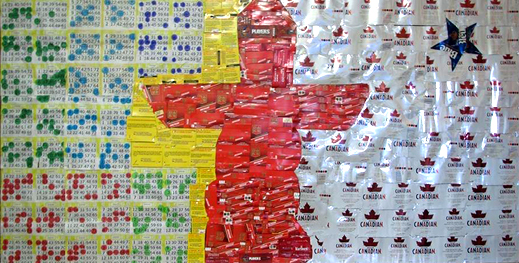
Tungilik challenges views on Inuit art – the work above, selected for the Venice Biennale, is a poignantly comic take on the territory’s addictions—gambling, smoking and drinking
Intercreate.org, Te Matahiapo Indigenous Research Organisation, Creative New Zealand and the Western Institute of Technology at Taranki are honoured to host two Nunavut (Canadian Inuit) artists to the SCANZ residency: Jesse Tungilik and Stacey Aglok MacDonald. They will attend the SCANZ2015:water*peace international celebration of water and peace in Nga Motu New Plymouth from January 17th to February 1st. Both embrace the difficult and complex questions of what identity means in current society.
The Nunavut Territory is the newest territory in Cananda, and one of the largest and least populated regions in North America and Europe. Nunavut have lived there for at least 4000 years. The land claims agreement with the government of 1992 was ratified by 85% of Nanavut and the territory officially established in 1999.
Both artists will have work on show on the final weekend of SCANZ, Saturday 31st and Sunday 1st February in Huatoki Plaza and Puke Ariki landing. Aglok MacDonald’s video work will be projected under the road at the sea end of Puke Ariki landing, and the site for work by Jesse Tungilik will be revealed on the day.
Jesse Tungilik is a Pangnirtung, Nunavut-based bench jeweler and contemporary Inuit artist who grew up in several different communities in Nunavut and the North West Territories. His first foray into the Inuit art world was when he was just eight years old working after school at the Matchbox Ceramics Gallery in Rankin Inlet, and had his first show a year later at a bank lobby in Yellowknife, NWT.
He then took a hiatus from art to pursue education and his other passions such as travel and environmental and cultural advocacy. These passions brought him far and wide from the vast ice fields of Antarctica, to the Moai of Easter Island to the Steppes of Mongolia. He has worked extensively with indigenous people’s organizations both professionally through positions with the national Inuit organization Inuit Tapiriit Kanatami, the National Inuit Youth Council, the Arctic Council Indigenous Peoples Secretariat, and personally; participating in Indigenous youth exchanges in Norway and Finland.
Jesse rekindled his love of creating art in his mid-20s working at the Aayuraa Jewelry Studio in Iqaluit where he was mentored by master artist Mathew Nuqingaq. Jesse has drawn inspiration from his many adventures and encounters with indigenous peoples from around the world to create art that reflected his experiences. He has strived to push the boundaries of his creative practice by experimenting with many different art forms and media. In addition to the jewelry that he makes primarily out of silver, ivory, baleen and muskox horn, he has painted public murals, made mixed media sculptures, created political assemblage pieces, dabbled in charcoal and oil pastel portraiture, and has written short fiction stories.
His work has been exhibited at Nunavut Arts and Crafts Association Art Festivals in Iqaluit, Nunavut and at the Great Northern Arts Festival in Inuvik, NWT and has also been featured in publications such as Up Here Magazine and Northern Public Affairs Magazine. Currently, his focus has shifted to arts administration working for the Government of Nunavut Department of Economic Development & Transportation as Intern Manager of Cultural Industries.
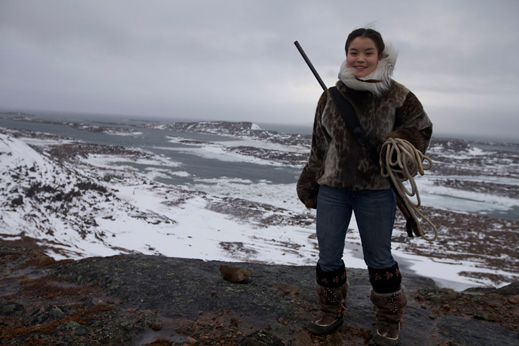
This is a production still from ‘Throat Voices’ produced by Stacey Aglok MacDonald, which addressed complex issues of culture and identity, embracing Nunavut identity and including issues that are pertinent to New Zealand – youth suicide for one
Stacey Aglok MacDonald is originally from Kugluktuk, a small community in western Nunavut. She first became involved in filmmaking in 2004 as a production assistant and character on the documentary series Staking The Claim: Dreams, Democracy and Canadian Inuit, which is now used as educational curriculum in high schools across the Nunavut territory.
Other projects that she has led have included training youth in over 20 communities across Arctic Canada in film production and editing, and producing workshops for youth on Acting and Performance as well as Inuvialuit Drum Dancing.
In 2012, Stacey won a Canadian Screen Award for Best Short Drama for her 17-minute live-action film Throat Song. She has produced a number of music videos in collaboration with other Nunavut-based filmmakers and musicians including The Jerry Cans and The Trade Offs. Today she is producing and directing two Inuktitut television series which are broadcast on the Aboriginal Peoples Television Network, one of which is a popular youth-oriented television show called Qanurli? and the other is a call-in talk show called Qanuq Isumavit.
She has a feature film in development and plans on writing and directing a new short film in the coming year. Stacey currently resides in Iqaluit, Nunavut with her 6 year old daughter.
Calling kids and families
/in 2015 Schedules /by Ian ClothierIntercreate.org and Quirky Creative are pleased to announce a suite of workshops themed on water and peace, as part of SCANZ2015 International Celebration of water and Peace. The workshops are for ages 5+ up to adults, and whole families are welcome. A week of workshops begins Monday 26th January and runs through to Friday 30th.
If you have an interest in mosaics, tie-dye Hippy peace culture, raindrop art, or tiny art projects to be abandoned and found, read on. Some of the outputs from the workshops will be on display in Huatoki Plaza on the 31st of January.
Quirky Creative – SCANZ 2015 Water and Peace Programme
Mon 26 Jan 1-4pm
Vessels: Mosaic baths for birds or bees, or mosaic glass water bottles
Kids will be making shallow mosaic dishes for birds, or for bees (bees need water too! And they adore blue things). Adults and older kids have the choice of starting a more intricate stained glass mosaic on a glass water bottle suitable for the dining table.
Tue 27 Jan 10am-1pm
Psychedelic Hippy Day: Tie-dye shirts with a peace message
Hippy philosophy is about more than the rainbow tie dye, but it is an eye-catching way to say something important. Make a shirt to wear at Saturday’s public gathering! BYO white cotton t-shirt. We will have fabric panels available if you can’t bring a t-shirt.
Wed 28 Jan 1-4pm
Raindrop Art: Glistening drops to display later at Huatoki Plaza
We’ll use several different art forms, including Zentangle, to create raindrops – take some home, donate some for Saturday’s display.
Fri 30 Jan 10am-1pm
Art Abandonment: Tiny projects made to be abandoned and found
Stencilled rocks, bottlecap collages, woolly octopus, and some other surprises – abandoned art is made to be left somewhere around town, with a tag for the finder to let us know what they found and where.
Sat 31 Jan 11am-4pm
Visit the Quirky Kids space at the Huatoki Plaza
Workshops held at Creative Focus, Block C, WITT
Booking is essential due to limited spaces. For more info contact Quirky Creative.
Water health with Kevin Archer and Chris Fowles of TRC
/in 2015 Schedules /by Ian ClothierThis is the programme for the activity led by Chris Fowles and Kevin Archer, as part of SCANZ 2015 International Celebration of Water and Peace in central New Plymouth on Saturday 31st January 2015.
11.00am -11.30am
· We will talk in general terms about Council monitoring of Taranaki rivers and streams and in particular the Huatoki Stream, focusing on the macroinvertebrates and how we use their presence or absence as an indicator of water quality.
· We will mention our school’s education programme from primary up to Y13 science programmes involving our use of SHMAK ( Stream Health Measurement and Assessment Kit).
· We will touch on how we also use water turbidity and temperature readings as other indicators.
· We will have on display several trays of water samples(containing invertebrates) that we have taken earlier in the morning from a site further upstream. We will have on hand appropriate identification sheets to help us come up with a ‘score’ for the water quality at that site.
11.30am-12.15pm – Practical session
For safety reasons we will not expect people to get into the stream but Chris and I will as we will be wearing waders. We will gather samples from the stream, put them into our large white trays and ask people to try and identify the invertebrates along the same lines as we did in the talk itself. Again we will have appropriate identification sheets on hand. We will also get some people to look along the turbidity tube to gauge the clarity of the water plus ask people to read the thermometers.
12.15pm -12.30pm – review of session and questions.
SCANZ 2015 programme
/in 2015 Schedules, Featured /by Ian Clothier
This is the final programme for SCANZ 2015 events running from Friday 30th January to Sunday February 1st.
SCANZ 2015 INTERNATIONAL CELEBRATION OF WATER AND PEACE
Artists and performers from Aotearoa New Zealand, Australia, Canada, America, Vanuatu and Nanavut Territory
Night time projections Pukekura Park 9-11pm Friday 30th January, starting at the Boat Shed Lawn
For further information in the form of short descriptions of the works to be projected, read more here.
International Day in Puke Ariki Landing and Huatoki Plaza 11am – 4pm Saturday 31st January
11-4pm Artworks will be displayed along the Huatoki stream, from the sea end up to Redcoat Lane.
Allan Giddy (NZ/Australia) has an installation where the Huatoki meets the sea. Tracey Benson (Australia) will be at Huatoki Plaza to demonstrate her augmented reality installation Words for Water. USA artists James Werner and Ava Werner have a GPS locative work and an installation respectively in Sir Victor Davies Park. Prim Rose Wari (Vanuatu) has woven work near the Red Coat Lane bridge, along with Vicki Smith from the West Coast of the South Island.
11am – 4pm – Fluid City, artists from the University of Auckland with activities for all ages, up in Huatoki Plaza.
11am – 4pm – Children’s art about Water and Peace, made at the Quirky Creative workshops during the week.
11am – 12.30 – find out all about water for kids of all ages with Kevin Archer, TRC Education Officer and Chris Fowles. The session includes looking at water samples for the tiny creatures living there and finding out how healthy the water samples are. Chris and Kevin will be there in thigh waders and take samples from the Huatoki Stream. They will be on Puke Ariki landing.
1.00pm – Dance performances in the lower area of Huatoki Plaza.
2pm – Launch of the Vanuatu Women’s Water Music DVD beginning in Huatoki Plaza and moving to at Puke Ariki landing.
2.30pm – Riverside cinema – video by artists on water and peace under the road at Puke Ariki landing.
7.00pm – 11pm Riverside cinema – video by artists on water and peace under the road at Puke Ariki landing.
Walking hui-symposium on water and peace 11am – 4pm Sunday 1st February, meet at Huatoki Plaza
Take part in discussions about water and peace, and hear artists talk about their work.
RAIN VENUE: ART / F BLOCK, WITT (20 Bell Street, New Plymouth)
11-4pm Artworks along the Huatoki stream (see above for details). If it rains, the Walking Symposium will be held up at the WITT campus – meeting at F Block.
7.00pm – 11pm Riverside cinema – video by artists on water and peace under the road at Puke Ariki landing.
Come along and join any event for as long as you like, there is no need to book
Sponsored by Intercreate.org, Creative New Zealand, Te Matahiapo, TSB Community Trust, Western Institute of Technology at Taranaki and the Intercreate.org community
Quirky Creative – SCANZ 2015 Water and Peace Programme
The following programme is for ages 5+ to adult – bring the family!
Mon 26 Jan 1-4pm
Vessels: Mosaic baths for birds or bees, or mosaic glass water bottles
Tue 27 Jan 10am-1pm
Psychedelic Hippy Day: Tie-dye shirts with a peace message
Wed 28 Jan 1-4pm
Raindrop Art: Glistening drops to display later at Huatoki Plaza
Fri 30 Jan 10am-1pm
Art Abandonment: Tiny projects made to be abandoned and found
Sat 31 Jan 11am-4pm
Visit the Quirky Kids space at the Huatoki Plaza
Programmes held at Creative Focus, Block C, WITT
Booking is essential due to limited spaces. For more info contact Quirky Creative.
Vanuatu Women’s Water Music
/in 2015 Projects, Featured /by Ian ClothierA special feature of SCANZ2015:water*peace is the Aotearoa New Zealand launch of the Vanuatu Women’s Water Music DVD. The Water Music dance involves the performers standing waste deep in the water, and slapping the surface as part of the dance. This is performed by the Leweton Cultural Experience. They are based on the remote northern islands of Gaua and Merelava in Vanuatu, and live in a village in Espiritu Santo where they present, share and maintain their unique cultural traditions and practises across cultures and generations.
Wantok Musik and Intercreate.org in association with Te Matahiapo Indigenous Research Organisation, Creative New Zealand, TSB Community Trust, the Western Institute of Technology at Taranaki and the Intercreate.org community are honoured to host two members of the Leweton Cultural Experience, Sandy Sur and Prim Rose Wari who will attend SCANZ2015:water*peace, and take part in the International Celebrations of Water and Peace from Friday January 30th to February 1st in central Nga Motu New Plymouth, based around the Huatoki stream walkway and plazas. The SCANZ residency begins on the 17th of January with many projects presented on the celebration weekend.
Following is an account of the development of the water dance.
The History of the Magical Water Music
My name is Warren Wevat Wessergo. I come from a village called Dolap in West Gaua.
All of the women from the Banks Islands, in the north of Vanuatu, can make music by splashing the water. This is very common. But this is just a standard sound all over the islands. However, in 1974, my aunt, Elizabeth Womal Marego, with her daughters, and my mother, Zalet (Charlotte) Hilda, with my sisters, they all came together to discuss the development of the ‘sound of splashing water’ into something more like ‘water music’.
The reason that these women decided to explore the idea of developing the ‘water music’ was that they had noticed the people on yachts displayed an increasing interest in the practice. Indeed, one of these yachtspeople had given a “Visitors Register” book to a Catechist on the island by the name of Patteson Worere. Patteson kept the book in the church and all the visiting yachts to Dulap were asked to nominate someone to enter the name of the yacht and their signature into the Visitors Register.
After all the discussions, Elizabeth, Zalet and their daughters chose Rovan Womal Marego to be the first leader of the Water Music group. Rovan worked with the women to codify and name the various sounds, beats, rhythms and chords of the water music. This is important because no one had ever given a name to the sounds of the splashing water before. Before they could create new sounds, they need to name the existing sound. So Elizabeth and Zalet decided that the first task for Rovan was to lead the group through the process of naming the existing sound from splashing water – the sound that was practiced all over the Banks Islands. They named this vus tuwal.
Then they named the four other ‘beats’ that they had just created:
kor nē-bē – the sound of rainwater falling over stones
ne kia – the sound of dolphins flapping their fins on the water
nē-rē – the sound of rainwater falling on leaves and thatched roof
vus ero – the sound of people chasing and shepherding fish into traps and nets
Elizabeth and Zalet and their daughters spent the rest of the year practicing the newly created beats and rhythms close to my house in the water at Lembrig Spring. Then in 1975, some more yachts visited West Gaua asking to hear the Water Music. My sister Martha Rowon was practising the new Water Music at the seashore. Some yachts in the area could hear the sounds that she was making. Intruiged by the strange tonal qualities of the music, the yachts searched for the source of the sounds. Eventually they found Martha on the reef and some of them were so impressed with the music that they presented Martha with gifts of clothes, shoes, and jewelry. This was the first instance of someone attracting visitors especially to see and hear the Water Music.
In August 1975, another yacht visited the area. These visitors also brought with them a camera. Many of the villagers were excited by the camera and the opportunity to have their photo taken. In all the excitement, a small boy was washed off the reef by a large wave while his parents were distracted by the camera. Eventually his drowned body was found and brought ashore. The local pastor at the time was a cousin of Martha. His name was Father Marcel Wewot. Father Marcel prayed for the boy to bring him back to life. Miraculouly, he was successful so he baptized him Wewot Lembrig. So now, every year during yachting season, the daughters of Elizabeth and Zalet, and the daughters of their daughters, they go down to the reef at Lambrig Spring and entertain the visitors with the magical water music. At the end of their show, the owners of the yachts hand over bags of second hand clothes, shoes, and other gifts and everyone remembers the miracle of Wewot Lembrig.
Time went by without much significant change. [There was plenty of migration of people from Gaua and neighbouring Merelava to (and from) Luganville, on the island of Espiritu Santo.] Tourists would come on yachts during the dry season and the women would perform the water music in exchange for some gifts. Then in the year 2000, Mr Sandy Sur brought some tourists to Dulap on a cruising yacht. But this time, the tourists were so impressed that when Sandy suggested that the tourists pay the women with cash, the tourists were happy to oblige. And so this occasion marked the transition from an amateur folkloric performance into a professional, revenue-raising, tourist attraction. The word passed around amongst the other yachties and tourists that there was a magical water music performance to be seen in Dulap and so many other tour companies and independent yachties started to come to Gaua. And so this occasion marked the transition from an amateur folkloric performance into a professional, revenue-raising, tourist attraction. We had begun the process of commercialising the water music.
A few years later in 2003, the Provincial government of TORBA held an Arts Festival in the village of Aver at North Gaua. The women from Dulap made their way to Aver for the Arts Festival and for the first time, performed the new water music for the Vanuatu public (as opposed to tourists). The people of North Gaua and the other visitors were amazed at this new water music. There were two English volunteers teaching at Losalava school at the time and they helped the news of the new water music performance reach the community in Port Vila. This was the first time that Tom Dick from Further Arts had heard of the water music, but his ethnomusicologist friend Monika Stern, had recorded the water music in Merelava some years before. Tom and Monika presented the idea of the water music to the Head of the Delegation of the European Union, Nicolas Berlanga Martinez. Nicolas was also very impressed with the water music and he arranged for some of the family members to travel to Zaragoza in Spain for the World Expo of 2004.
Then Sandy Sur organized a meeting of the Mwerlap-speaking diaspora of people from Gaua and Merelava who were living on a block of land in the Sograon (Showground) area just on the fringes of Luganville – the “northern town” as it is known by residents of the capital, Port Vila, in the south – or “Canal” as it is known by locals of the island of Espiritu Santo. By this time, many of the original innovators of the water music from 1974 were living in Luganville. Through this meeting Sandy galvanized the family around the performance of “water music”. Sandy knew the potential of the cultural practice of the water music as a tourist spectacle.
During the course of the meeting several different activities were suggested as being able to be presented as a package to tourists. These activities included traditional dance (terrestrial) of men and women respectively – and a communal dance featuring the whole community. Warren was adamant that the water music had to be a feature of the package of activities that were presented to the tourists. It was important that this will of Warren be clear to all as it is Warren’s mother and Aunt and sister who were the original innovators of the water music in 1974 in the nasara of Wevat Wessergro, Saint Bartholomew, West Gaua. To this end, the meeting continued long into the night, and also moved down to the shore where the men and women could stand in the water and visualize the water music, and test and demonstrate the possibility of its transmission. In the end, Hilda Rosal Wavales Warren, Warren’s wife, was appointed to the role of Maestra (Creator, Composer and Teacher) of Water Music for the Leweton community.
Hilda worked very hard to develop the water music and to engage all the women and girls in the community. It is largely due to her hard work that we can say that the Leweton Cultural Group has become so popular and that the Vanuatu Women’s Water Music is known around the world. Hilda created eight more water music chords which are totally different to the original sounds and the other five beats listed above, and each of the eight new ones have their own names and meanings. These names and meanings were developed through a collaborative process involving the full community going to the ocean’s edge to listen to the women performing the sounds and the community would listen to the music and share their thoughts and feelings as to the meaning and names of the sounds. Chief Colin, Kuber, Judah, Sandy Sur, and other chiefs and community leaders were there. All the participants had a pen and paper and they wrote down their ideas for the names and meanings of the songs: sometimes the meaning of the song was attributed to the ocean, other times to the sky or the land. All of the names and meanings were assigned in the Mwerlap language which is the language of Merelava and East Gaua, and each of them are a product of Leweton.
This information has been presented by Warren Wevat Wessergo from West Gaua. This is his story. Additional information has been compiled by Sandy Sur and Thomas Dick. Translated from bislama by Thomas Dick.
SCANZ 2015 water and peace map
/in 2015 Locations, Featured /by Ian ClothierClicking on the photograph below will take you to a map and folder of images of the Huatoki stream walkway from the sea to Redcoat Lane. This is the path of the locations of SCANZ2015 water*peace artworks, presentations and installations.
The map shows the locations for art works, performances and activities that occur on the final weekend of SCANZ2015 – Saturday 31st of January in Huatoki Plaza (11am – 4pm), and Sunday 1st of February (11am – 4pm) along the Huatoki from the sea to Redcoat Lane. There are also night time projections in Pukekura Park on Friday 30th of January, 9pm to 11pm.
 |
| SCANZ2015 sites |
Below are the photographs in a slideshow.
Huatoki Walkway announced as site for SCANZ water*peace art works
/in 2015 Locations /by Trudy LaneHuatoki walkway announced as site for SCANZ water*peace art works
The Huatoki walkway and Plaza are now reserved for SCANZ 2015:water*peace events. We are particularly pleased the New Plymouth District Council has supported our project in this way, as it means we will be able to locate creative works along the Huatoki walkway, for temporary exhibition on Sunday February 2nd 2015.
The Huatoki River is site of many stories, dating from pre-European times to industrial usages, through to the current walkway/recreational purpose. A range of site types can be offered to successful artists.

Looking upstream from the previous photo. This part of the Huatoki runs in front of Puke Ariki museum and Library

A slightly better view of the lower part of the landing area, which is landscaped back up to the right, until Puke Ariki Museum is reached

Looking upstream from the landing, the Huatoki again passes under a road. Beyond the pipe and through the other side you can see where the stream drops 30-60cm (1-2 feet)
Intercreate.org is proudly powered by WordPress

